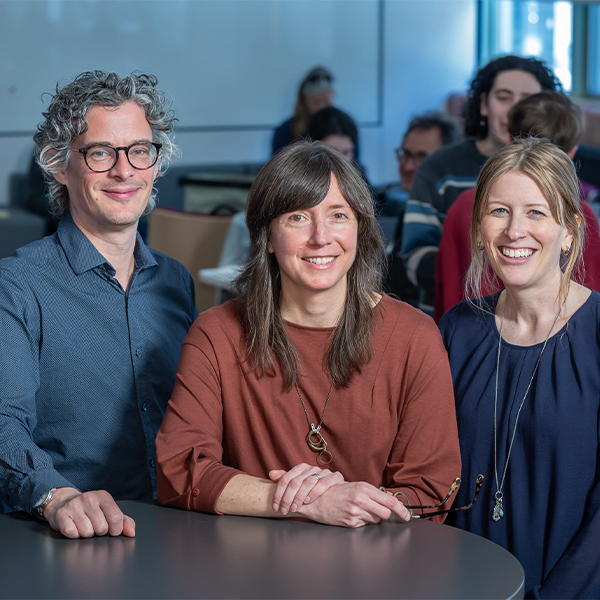In the Olympic decathlon, athletes run, jump and throw their way through a grueling series of tests of skill and endurance.
In the Solar Decathlon, students from around the world face their own hurdles as they design and build a solar-powered home for the international competition’s 10 contests.
TeamMTL is the only Canadian entry in the Solar Decathlon China 2018. The team consists of about 55 McGill and Concordia University students, as well as faculty advisors from the two universities.
So how difficult is it to organize a multi-disciplinary project of this magnitude?
“Horribly difficult. Like terrifyingly,” laughs Michael Jemtrud, MArch’00, an associate professor at McGill’s School of Architecture and the faculty lead for the project.
“Shipping a building to China is not an easy thing to do,” says Jemtrud, who adds that the project’s organizational and overall logistics are daunting. “But we’ve learned a lot.”
Teams taking part in the competition have to build a two-storey, solar-powered home for a family and equip it with appliances.
But that’s only part of the marathon.
TeamMTL’s home will have to be rebuilt in China for the competition. During the event, they’ll also have to prove its energy efficiency by doing tasks like running loads of laundry, cooking and driving an electric car each day that’s been charged by the solar energy produced by the house.
And while fundraising isn’t one of the 10 contests, TeamMTL also needs to raise money to finance the project.
The McGill/Concordia team’s simulations show the row house they’ve designed will be net energy positive in China, says Jemtrud, meaning it will basically produce more power than it consumes.
The house, which has a solar-paneled roof, was designed to have two zones that can be divided up depending on what the homeowner’s family unit looks like.
It could be a single family home, says Ben Wareing, MArch’14, who is working on his PhD in architecture at McGill and is the architecture lead for the project. Or you could have a tenant or granny flat at the rear of the house, which has its own kitchenette and accessible bathroom, Wareing adds.
“So we’re looking at inter-generational kinds of configurations.”
Designed for Montreal’s urban fabric, the row house includes an integrated courtyard “which also speaks to the Chinese context,” says Wareing.
They’re using “passive house” principles—an approach to construction where you limit energy consumption by 80 per cent just through smart design, including super insulation and air tightness, he says.
With help from Concordia’s Topological Media Lab, interactive media installations in the house will provide real-time feedback about water and electricity consumption and overall energy efficiency.
Nima Navab, a computation arts student at Concordia who is managing the project’s media design team, says the team is working on creating subtle cues to homeowners through background lighting and playing with shadows. “We didn’t want to shut off their valve or a red light to go on,” Navab says.
Natalie Manukian, an undergraduate at the McGill School of Environment, is working on communications for the project.
“I’ve never heard of an experience where McGill and Concordia students are in the same class,” says Manukian, adding that she has really enjoyed the opportunity to work with design and engineering students from Concordia.
Launched by the U.S. Department of Energy, the first solar decathlon was held in 2002.
The 10 contests for the upcoming competition in China range from energy performance and architecture to innovation, home life and communications. Five are juried and the performance-based ones are measured, says Jemtrud.
“When they first started this, it was still really R&D like, but now the solar is actually the easiest part of the project.”
The house was originally designed as five pre-fabricated modules, but because they have to ship it to China, it has to be panelized construction, which meant using a company in Maine.
The hope is that the panels will arrive mid-May, then work on building the house —somewhere near or on campus at McGill or Concordia—can start.
The idea is to open the house for guided tours and fundraising events during the summer, but also to use that time to test things out, before dismantling the house in the fall.
A TeamMTL delegation of students and faculty will travel to China in July 2018 for the event.
They’re about halfway toward their fundraising goal for the project, Jemtrud says, and still need to raise about $280,000 to $320,000. The team recently received a $50,000 grant from Natural Resources Canada’s Program of Energy Research and Development.
If they deliver the house on site to specifications, the city of Dezhou will buy it. In the previous competition in China, the amount paid for each house averaged about $400,000 USD, Jemtrud says. Moreover, the winning team gets $500,000 USD.
TeamMTL’s plan is to use any money it comes home with to build one to three homes in Montreal, which would be given away.
“I think it’s a huge learning experience,” Jemtrud says. “You can still check off all of your pedagogical academic boxes with it, but it’s life transforming for the students… It’s an experience that you just can’t get in a classroom.”
Students in different disciplines are getting the chance to collaborate on a largescale initiative with real-world implications, he adds.
“I think project-based activities like this—they’re really messy, but because they’re messy, they involve so many different things. And people learn so much more. It’s not a controlled lab experiment, for sure.”


